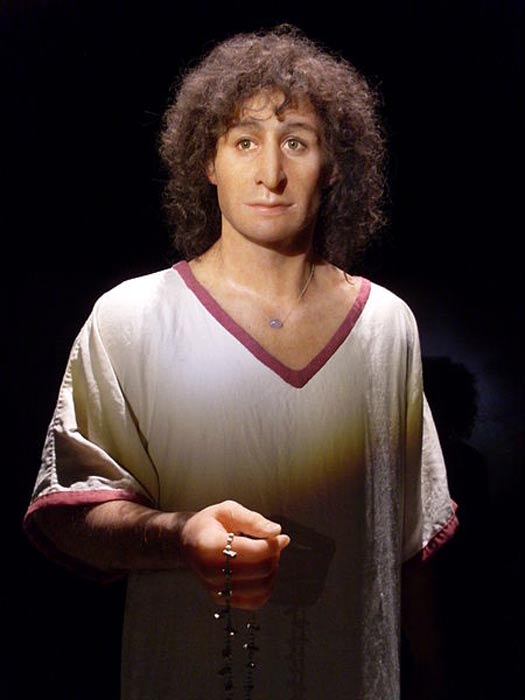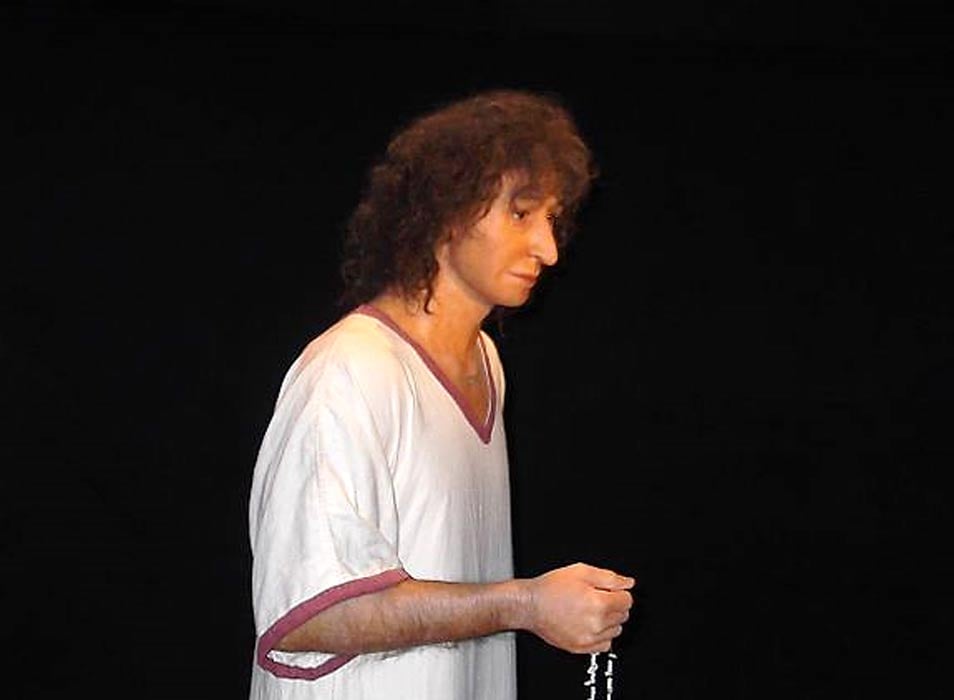2,500-Year-Old Phoenician DNA Linked to Rare and Ancient European Ancestry
Researchers have sequenced the first complete mitochondrial genome of an ancient Phoenician. The results of the studies of the remains of a man called the "Young Man of Byrsa" and "Ariche” has linked him to a very early and rare haplogroup found in Europe.
GenomeWeb reports that the Young Man of Byrsa had a mitochondrial genome “from the haplogroup U5b2c1, considered to be one of the most ancient haplogroups in Europe, and associated with hunter-gatherer populations. The U5b haplogroup is thought to have arisen in Europe between 20,000 and 24,000 years ago.”
Lisa Matisoo-Smith of the University of Otago in New Zealand and co-leader of the study said in a statement "While a wave of farming peoples from the Near East replaced these hunter-gatherers, some of their lineages may have persisted longer in the far south of the Iberian peninsula and on off-shore islands and were then transported to the melting pot of Carthage in North Africa via Phoenician and Punic trade networks,".
The U5b haplogroup is considered to be rare in modern populations - all of the reported carriers are of European ancestry and from Spain, Portugal, England, Ireland, Scotland, the US, and Germany. As professor Matisoo-Smith told Phys.org: “It is remarkably rare in modern populations today, found in Europe at levels of less than one per cent. Interestingly, our analysis showed that Ariche's mitochondrial genetic make-up most closely matches that of the sequence of a particular modern day individual from Portugal.”
- 2,700-year-old Phoenician Shipwreck Discovered in Maltese Waters
- The Phoenician city of Tyre - A rich history of industry, mythology and conflict
This is something of a surprise for the researchers, who wrote in the journal PLOS One “Though it is believed that Carthage was established by colonisers from Tyre, in what is today Lebanon, it is unlikely that our Phoenician young man had maternal ancestry that traced back to this founding population […] as the haplogroup U5b2c has not been identified in our modern Lebanese samples or in ancient (early Neolithic, PPNB) remains from the Levant.”

The skeleton of the Young Man of Byrsa that was found in Carthage. (Public Domain)
The remains of “Ariche” were discovered in 1994 at Byrsa Hill when a gardener happened upon his tomb while preparing to plant a tree for the National Museum of Carthage. Byrsa Hill is located in Tunisia, at a site which was once a Phoenician acropolis.

District of Punic Byrsa in ancient Carthage, Tunisia. (CC BY SA 3.0)
According to the American University of Beirut (pdf), the young man’s tomb held “2 sarcophagi carved in the sandstone. The left tomb contained the skeleton of a young man lying on his back, his arms bent on his abdomen. The sarcophagus to the right was empty.”
The young man of Byrsa was described as a “robust young man around 1m70 [5.58ft.] high, with a long skull, broad forehead, and a squarish chin.” He was estimated to be between 19-24 years old when he died. Punic inscriptions called him Arish “the beloved one.”
- Treasure trove of ancient Phoenician artifacts uncovered in Lebanon
- The Beautiful and Complex Artisanship of Glass-making in the Ancient World
Some of the objects found with the remains included two Punic amphorae, a Punic lamp, bones of a sacrificial goose, and some small Egyptian type ivory amulets. These and other artifacts helped to date the tomb to around 500 BC.

Reconstruction of the Young Man of Byrsa. (Public Domain)
The new study helps provide a little more information about the influential and relatively mysterious Phoenicians. It is known, however, that “The Phoenicians were the direct descendants of the Canaanites of the south Syrian and Lebanese coast who, at the end of the second millennium BC, became isolated by population and political changes in the regions surrounding them.”
Despite the fact that Phoenicians were so well-known in the ancient world and they have been acknowledged for their links to the early Greek alphabet, there are few of their own written texts that have survived the passing of time. This lack of information has led modern historians to mostly rely on Egyptian, Assyrian, Babylonian, Greek, and Roman sources for data on the ancient people.
Top Image: A reconstruction of what the Young Man of Byrsa may have looked like. Source: Public Domain


















Comments
I look at the recreation of this skeleton and it does not look like a very good reincarnation of what he may have looked like. the skeleton shows a prominent set of perfect teeth and wide set eyes, and the illustrated image shows eyes closer together. And the skull is wider by far at the top, yet the model narrows. There is no bone or cartilage to indicate an elongated nose ...is that just the imagination of the person who did the model? And if this is an illustration of a very ancient European image...why would there be such curly hair when this is not a usual characteristic of the ancient Euros who are found with straight fine hair? Normally I find such visions created from skeletal remains quite intuitive. This one to me seems off.
Great effort of Timeline here but please convince me that the Zoroastrian Region based on Truth and Good Will was wrong… From what I understand it may have been the more righteous origin of those that plagiarized and followed. In fact...as I understand it...the infuence through Esther this early faith was a huge influence on the “Pantheistic" sect of the Hebrews that were not privy to the writing of the Dead Sea Scrolls for reasons of greed and opportunism.
I’m not sure you have the true History under your belt here, Animism and Pantheism is the origin of Zoroastrianism...Correct? Zoroastrianism was not Islam. The Islamic faith and the Ottoman Empire came later correct? Please enlighten me to your assumptions here. Is it the “Destroy all Evil” thing? Please go make sure that the direction you are going is the true facts of this particular Religion before trying share the facts...Because we are now living the results of all these “Replacements" for Zoroastrianism… They are not working at all.
It is frustrating that the obvious answer from the cumulative evidence to date it that Plato's "Atlantis" was obviously a Mediterranean federation of states dominated by Crete until the eruption of Thera put an end to this civilization. The Phoneticians, Carthaginians, Southern French and Spanish, Mycenaeans, Etruscans, Anatolians were all peoples of one culture that was dominated by an Earth (Snake) Goddess religion. The eruption of Thera and slow painful decline toward the Bronze Age Collapse led to a fragmentation of this federation and the eventual psychological breakdown of some cultures in the region. It led eventually to the pathological religions of the Greeks and Romans, themselves perverted by the invasions of Aryan-Zoroastrian ideas and peoples from the East, which in turn led to the genocides of Phoenicia, Carthage, Etruria and the remaining peoples who held onto the old ways; it led to the annihilation of their cultures, the written histories and philosophies, and the usurpation of their technologies.Essentially what the Nazis would have done if they had won. The eradication of history. Look at what the Greeks built in Alexandria. A system of intelligence gathering and thought control the NSA would envy. The Romans took it over, just as the Americans took over the British Empire. The rest is "history" or better said theirstory.
Our civilization is built on the ancient and murderous lies of the Greco-Roman "historians" that academics refuse to accept as falsehoods, despite the evidence. Why no surviving written documents from civilizations as great as Crete or Carthage is the obvious question to ask, but never is. And yet, as Graves so clearly showed, even without these histories, the traceable lineage of the Greco-Roman mythologies still tell us much. When they could no longer trust in the love of the Earth (their mother) these decaying states looked to the Sky (their father) and made up a new pathological mythology of paranoia, violence, invasion and extortion. Why did the Greeks feed their women on half rations and not allow them to study, to exercise, or congregate, or even leave their homes without male supervision? Why were their "priestesses" treated like hostages? What could they possibly fear from their womenfolk, their own kin, their daughters and wives? The relationship between Pandora and Eve is so blatantly obvious that it doesn't need explanation. They are practices still perpetrated today all over the world. Is it any wonder that we are in such a sorry state. A permanent state of fear and denial.
Why are this U5b and its accosiates an "mistery" to some, when the evidencs is there fo an entrily different explanation to this, and where they came from, and it suprices me that I have to correct the present "facts" of history.
There is 2600 years old Arab coins and the to the Eufrat/Tigris area, litred in the scandinavian lands, why dont we talk about that, and so on.
Have you infact read about some genetic reseatches about Finns/Lapps in the Nordic lands, and its ancient conection to the Basque people, and to Berners in Africa.
Why do we have to point that out all the time, and bigg ocean going wessels existed thousands of years ago, that one is flatly denied, since we where "cave dwelles", bearly having invented the wheel.
But hey, its an "conspiracy" isnt it.
peace
Did they use Kenny G as the model for this Young Man of Byrsa?
Pages